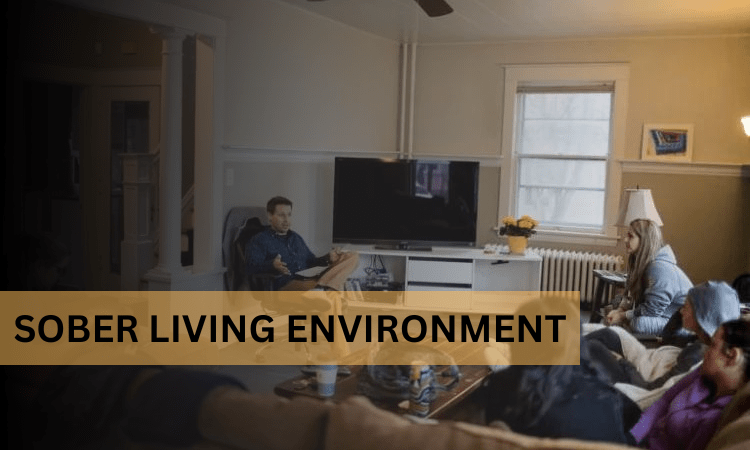Addiction recovery is a challenging journey that involves medical, psychological, and social support. It usually starts with detoxification, followed by treatment programs, and continues with long-term support. Recovery isn’t just about quitting substance use; it’s also about building a healthy and fulfilling life.
The environment plays a crucial role in recovery. A positive, supportive environment can significantly improve the chances of staying sober, while a negative environment can increase the risk of relapse. The physical, social, and emotional aspects of an environment all influence recovery outcomes.
A sober living environment is a place where individuals in recovery can live in a supportive, substance-free setting. These homes provide structure, support, and a community of peers who are also working towards sobriety.
What is a Sober Living Environment?
A sober living environment, or sober living home, is a residence where people in recovery live together in a drug- and alcohol-free setting. These homes offer a safe space where residents can focus on their recovery with some structure and accountability.
Differences from Other Types of Recovery Residences
Sober living homes differ from other recovery residences like inpatient treatment centers and halfway houses. Inpatient treatment centers offer intensive support and medical care, while sober living homes are less restrictive and focus on peer support. Halfway houses often cater to individuals transitioning from correctional facilities and may have stricter rules.
Typical Features and Rules of Sober Living Homes
Sober living homes usually have a set of rules and guidelines designed to maintain a safe and supportive environment. Common features and rules include:
- Mandatory sobriety: In a sober living home, staying free from drugs and alcohol is essential. Residents must avoid all substance use. This rule helps create a safe and supportive space for everyone to focus on their recovery. Regular checks ensure everyone follows this rule, building trust and mutual support.
- Curfews: Sober living homes often have curfews to promote safety and accountability. Residents must return by a certain time, which helps maintain order and ensure everyone is present. Curfews also help residents develop routines and structure, which are important for a stable and sober life.
- Chores and responsibilities: In sober living homes, residents share household chores like cleaning, cooking, and maintenance. This keeps the home clean and teaches life skills. It also promotes a sense of community, responsibility, and teamwork.
- Group meetings: Regular group meetings are essential in sober living homes. These include house and support group sessions where residents share their experiences, challenges, and successes. They build camaraderie and mutual support, helping residents connect with others who understand and can offer encouragement.
- Random drug testing: Sober living homes frequently conduct random tests to ensure residents remain sober. These tests discourage substance use and help maintain a safe environment. They also add accountability, supporting residents in their recovery.
Does Sober Living Environment Play Any Role in Recovery?
A positive environment significantly impacts mental health and sobriety. Sober living homes offer stability, reduce stress, and provide a supportive community, which are all crucial for maintaining sobriety.
Research and Statistics Supporting the Effectiveness of Sober Living Environments
Studies show that sober living environments are effective for long-term recovery. People in sober living homes have lower relapse rates, higher employment rates, and better overall well-being compared to those who return to their old environments after treatment.
For instance, a study published in the Journal of Psychoactive Drugs found that residents of sober living homes had significantly lower substance use rates and higher employment rates than those in other living situations.
Personal Stories or Testimonials Illustrating Positive Outcomes
Many individuals who have lived in sober living environments share positive experiences. They often highlight the sense of community, support, and accountability that helped them stay sober and rebuild their lives.
How to Choose a Sober Living Home
When choosing a sober living home, several key factors should be taken into account:
- Location: Proximity to work, family, and support networks can influence the choice of a sober living home.
- Cost: It’s important to consider the affordability of the home and any available financial aid options.
- Rules and structure: Understanding the rules and structure of the home can help determine if it aligns with personal preferences and needs.
- Support services: The availability of support services, such as counseling, job placement assistance, and life skills training, is crucial.
Questions to Ask During the Selection Process
To ensure the chosen sober living home meets individual needs, consider asking the following questions:
- What are the house rules and expectations?
- What support services are provided?
- Are there any additional costs or fees?
- What is the typical duration of stay?
- Are visitors allowed, and what are the visitation policies?
Importance of Finding a Home that Fits Individual Needs and Preferences
Finding a sober living home that fits individual needs and preferences is crucial. A home that offers the right support, structure, and community can make a significant difference in maintaining long-term sobriety.
Benefits of Sober Living Environments
Sober living homes offer structure, accountability, a supportive community, access to resources, reduced relapse risk, and improved overall well-being.
Structure and Accountability
One of the main advantages of a sober living environment is the structure and accountability it offers. The rules and guidelines help residents establish routines and develop healthy habits, while the accountability of living with peers promotes responsibility and adherence to sobriety goals.
Supportive Community and Peer Connections
A supportive community and peer connections are vital components of a sober living environment. Living with others who are also in recovery fosters a sense of camaraderie and mutual support. These connections can offer encouragement, motivation, and a sense of belonging, which are essential for maintaining sobriety.
Access to Resources and Ongoing Treatment
Sober living homes often provide access to resources and ongoing treatment, such as counseling, support groups, and life skills training. These resources help residents continue their recovery journey and address any underlying issues that may contribute to substance use.
Reduction of Relapse Risk
Sober-living homes greatly reduce the risk of relapse by providing a stable and substance-free environment. The support and accountability in these homes help residents stay focused on their recovery goals and avoid triggers and temptations.
Improved Overall Well-being and Life Skills Development
Living in a sober living environment can lead to improved overall well-being and the development of essential life skills. Residents learn to manage their responsibilities, build healthy relationships, and develop coping strategies that contribute to long-term sobriety and a fulfilling life.
Sober Living Environment at Healing US
Healing US offers a range of sober living facilities designed to support individuals in their recovery journey. These facilities offer a safe, structured, and supportive environment where residents can concentrate on their sobriety and personal growth.
Unique Features and Programs Offered
Healing US sober living facilities provide unique features and programs designed to meet the needs of residents. These may include:
- Individual and group counseling
- Job placement assistance
- Educational workshops
- Recreational activities
- Peer support groups
Success Stories and Testimonials from Residents
Success stories and testimonials from residents of Healing US sober living facilities highlight the positive impact these environments have on recovery. Many residents share how the support, structure, and community helped them overcome challenges and achieve their sobriety goals.
FAQs
Que: What is the Typical Duration of Stay?
Ans: The usual duration of stay in a sober living home varies, typically ranging from a few months to a year. The duration of stay typically depends on individual needs and recovery progress.
Que: Are Visitors Allowed?
Ans: Most sober living homes allow visitors, but there are usually specific rules and guidelines regarding visitation to ensure the safety and well-being of residents.
Que: What is the Cost, and Are There Any Financial Aid Options?
Ans: The cost of residing in a sober living home can vary significantly based on the location and available amenities. In some cases, you may get financial aid.
Que: What Kind of Support and Services are Provided?
Ans: Support and services provided in sober living homes can include counseling, support groups, life skills training, job placement assistance, and access to healthcare resources.
Que: How is Privacy Maintained in a Communal Living Setting?
Ans: Privacy in a communal living setting is maintained through established house rules and respect for individual boundaries. Many homes provide designated personal spaces and private or semi-private rooms.
Conclusion
A positive sober living environment plays a crucial role in supporting long-term recovery. The structure, accountability, supportive community, and access to resources provided by sober living homes create a foundation for sustained sobriety and personal growth.
For individuals pursuing long-term sobriety, selecting a sober living environment can be a pivotal step. Living in a supportive and structured setting can greatly improve the chances of successful recovery and a fulfilling life.
Supportive environments are essential for successful recovery outcomes. By providing stability, encouragement, and a sense of community, sober living environments help individuals navigate the challenges of recovery and build a brighter future.
Our sober living facilities offer the stability, encouragement, and community you need to succeed in your recovery journey. Contact HealingUS today to learn more about how we can help you build a brighter, sober future.



